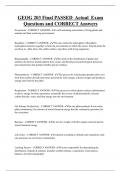GEOG 203 Final PASSED Actual Exam
Questions and CORRECT Answers
Ecosystems - CORRECT ANSWER- ✔✔a self-sustaining association of living plants and
animals and their nonliving environment
Biosphere - CORRECT ANSWER- ✔✔The area where the atmosphere, lithosphere,
hydrosphere function together to form the environment in which life exists. Extends from the
sea-floor to ~8km above the earth's surface, anywhere with living organisms
Biogeography - CORRECT ANSWER- ✔✔the study of the distribution of plants and
animals, the diverse spatial patterns they create, and the physical and biological processes,
past and present, that produce Earth's species richness
Photosynthesis - CORRECT ANSWER- ✔✔The process by which plants produce their own
food from carbon dioxide and water, powered by solar energy, releases oxygen and produces
energy-rich food for the plant
Respiration - CORRECT ANSWER- ✔✔The process by which plants oxidize carbohydrates
to derive energy for their operations; essentially the reverse of photosynthesis; releases
carbon dioxide, water, and heat energy into the environment
Net Primary Productivity - CORRECT ANSWER- ✔✔the net photosynthesis for an entire
plant communicty; the amount of stored chemical energy that the community generates for
the ecosystem
Biomass - CORRECT ANSWER- ✔✔the net dry weight of all this organic material and its
stored chemical energy
Life Zones - CORRECT ANSWER- ✔✔zonation according to altitude and vegetation; each
one possesses its own biotic communities
Limiting Factors - CORRECT ANSWER- ✔✔Factors responsible for determining the
distribution of plants & animals, includes weather/climate, competition, food sources,
humans, elevation/topography
,Primary succession - CORRECT ANSWER- ✔✔An area of bare rock or a disturbed site with
no vestige of a former community
Secondary succession - CORRECT ANSWER- ✔✔starts from remains of previous
community in an area that has been disturbed or destroyed
Pioneer Community - CORRECT ANSWER- ✔✔The initial plant community in an area,
usually found on new surfaces or those that have been stripped of life, as in beginning
primary succession and includes lichens, mosses, and ferns growing on bare rock
What does biogeography include? Describe its relationship to ecology. - CORRECT
ANSWER- ✔✔Biogeography includes the distribution of plants and animals, and Earth's
species richness. Relates to ecology because it looks at organisms and their environments,
like ecology.
Briefly describe the global pattern of net primary productivity - CORRECT ANSWER-
✔✔Tends to be highest between the Tropics of Capricorn & Cancer at sea level & decreases
toward higher latitudes and elevations
What are the principal abiotic components in terrestrial ecosystems? - CORRECT ANSWER-
✔✔Gaseous, hydrologic, and mineral cycles
Describe what Alexander von Humboldt found that led him to propose the life concept. What
are life zones? Explain the interaction among elevation, latitude, and the types of
communities that develop. - CORRECT ANSWER- ✔✔Observed that plants & animals recur
in related groupings wherever similar conditions occur in the abiotic environment. Life zones
are areas organized by altitude & vegetation, each contains its own biotic community. Higher
altitude is similar to travelling away from the equator to higher latitude, climate changes the
higher you go.
What is a limiting factor? How does it function to control the spatial distribution of plant and
animal species? - CORRECT ANSWER- ✔✔The one physical or chemical component that
most inhibits biotic operations, through either its lack or excess. It inhibits biotic operations,
hindering the growth of plants or animal species.
, How does ecological succession proceed? What are the relationships between existing
communities and new, pioneer communities? - CORRECT ANSWER- ✔✔Disturbances
destroy the old environment, a new one forms. Pioneer communities affect existing
communities.
Inner Core - CORRECT ANSWER- ✔✔Solid iron, most dense (13.5gcm-3)
Outer Core - CORRECT ANSWER- ✔✔Molten iron, magnetic field
Inner Mantle - CORRECT ANSWER- ✔✔Dense, contains a mixture of iron, magnesium, and
silicats, with some calcium and aluminum.
Outer Mantle - CORRECT ANSWER- ✔✔Divided into 3 layers: upper mantle,
asthenosphere, and uppermost mantle
Asthenosphere - CORRECT ANSWER- ✔✔Below the lithosphere, (43mi-155 mi), contains
pockets of increased hear from radioactive decay and is susceptible to slow convective
currents in these hotter, less dense materials.
Continental crust - CORRECT ANSWER- ✔✔20-60 km, 2.7g/cm3 density, essentially
granite
Oceanic crust - CORRECT ANSWER- ✔✔5 km, 3 g/cm3 density, basalt
Granite - CORRECT ANSWER- ✔✔Igneous rock, crystalline, and high in silica, aluminum,
potassium, calcium, and sodium
Basalt - CORRECT ANSWER- ✔✔Igneous rock, granular and high in silica, magnesium,
and iron
Isostasy - CORRECT ANSWER- ✔✔crust is constantly rising & sinking




